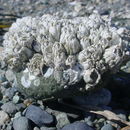pt-BR
nomes no trilho de navegação


Balanus glandula is an acorn barnacle, occurring in the high-mid intertidal of much of the rocky coastline of western North America, where it can be one of the most abundant solitary animals, reaching densities of more than 70,000 individuals per square meter (Morris et al., 1980; Ricketts et al., 1985).
“The sinuous line of contact between the terga and scuta distinguish this species from most other intertidal barnacles. Semibalanus balanoides has a sinuous line of contact but also has no centripetal ridges at the interior base of the shell. Chthamalus dalli has a straight, crosslike junction between the terga and scuta and the rostrum is overlapped by the rostrolaterals.” (Cowles et al., 2002)
Aleutian Islands south to Bahía de San Quintín in Baja California (Morris et al., 1980).
B. glandula has recently established in Japan and Argentine, likely introduced via shipping ballast water (larvae) or hull-fouling (adults). In Japan it competes with B. albicostatus (Kado, 2003).
B. glandula occurs in the high and mid-intertidal, attached to rock or other hard surfaces -- artificial (pilings, floats) or biological (other organisms). They’re common in the exposed outer coast, as well as in bays and estuaries. (Morris et al., 1980)
Mothers brood eggs, which are released into the water as nauplius larvae. These planktonic larvae undergo five molts to become a non-feeding cypris with six pairs of legs. Cyprids attach to suitable substrate (avoiding potential predators or competitors) and metamorphose into the adult form. They reach adult size in about two years. The entire lifespan is about 10 years. (Cowles et al., 2002)
Balanus glandula is similar in size and general shell morphology to Balanus crenatus (Morris et al., 1980).
On juveniles & adults: include Nucella lamellosa (snail); Lottia digitalis (limpet); Pisaster ochraceus, Pycnopodia helianthoides, Evasterias troschelli, Leptasterias hexactis (sea stars); Emplectonema gracile (nemertian worm); Onchidoris bilamellata (nudibranch), gulls, goldeneye ducks.
On larvae: include juvenile rockfish
(Cowles et al., 2002)
Shell to 22mm diameter (Morris et al., 1980)
Filters food (plankton and edible detritus) from the water during high tide, using it’s cirri (6 pairs of thoracic appendages).